❈ Building the Box Joint JigTo use this jig you will need a tablesaw, stackable dado set, and a calipers with dial or digital readout. You can purchase the dial type for $25-$50; digital models cost $60-$75. We've found a dial calipers essential because box joints must be cut with exacting accuracy. Why? Any minor error in the width or spacing of the individual "fingers," even .001", multiplies itself with every finger you cut.For reasons of design and proportion, you typically make the individual "fingers" in box joints as wide as the thickness of the workpieces. In this article, we'll make a jig for cutting 1/4" wide fingers in ¼" - thick stock (see the drawing below for the precise dimensions of the joints). For thicker or thinner stock you adjust the size of the jig's pin and the width and height of the dado cut accordingly. Scroll down to keep reading ... |
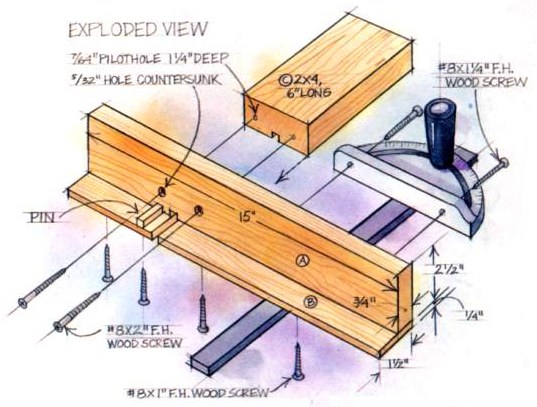 |
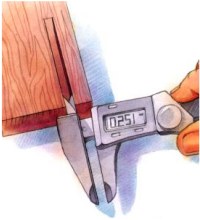 Step 1. Step 1. Cut parts A, B, and C to the sizes shown in the Exploded View drawing below. Any flat and straight stock will do. Step 2. Adjust your dado set for a cut that's .001" wider than the joint fingers (.251" in our example). With stackable dado sets you can place commercially made shims between the cutters, or make your own shims from various papers (standard tablet paper measures .002-.005" thick, some tissue and waxed papers measure .001" thick). Check your adjustment by measure a test cut with your calipers as shown here. Raise the dado set ½" above the tabletop. |
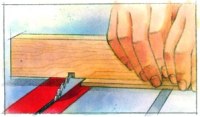 Step 3. Step 3.Cut the notch that holds the pin in part A. Do this by holding part A against the miter gauge with part B beneath it as shown. Do not cut into part B. |
 Step 4. Step 4.Cut a ¼" x ¼" x 6" strip of hardwood that fits snugly into the notch you just cut in part A. (The strip should slip into place, yet fit tightly enough so it doesn't fall out.) Cut a 1½" pin from the strip and glue it into the notch, flush with the back of part A. Save the leftover strip. Screw part B to part A. |
| Step 5. Set your miter gauge for a 90° cut. Use the leftover strip to position the jig assembly on the miter gauge. Do this by aligning the jig pin ¼" from the path of the dado set as shown above. With the pin aligned, temporarily clamp the jig to the miter gauge, then affix the gauge to the jig with screws. Replace the miter gauge into its slot and cut through parts A and B. Attach the blade guard (C) centered behind the notch you just cut. During this and the following steps, apply pressure to the miter gauge to hold its bar firmly against the right side of the slot. This will keep its distance from the dado set consistent during cuts. |
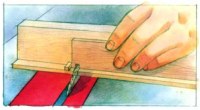 Step 6. Step 6.Position a piece of scrap stock as shown above, and cut a notch into the scrap piece. Position this notch over the pin and make another cut. Position that notch over the pin and repeat the cut. With your calipers, check the width of the fingers. They should be .001" under your desired finger width. (For our ¼" fingers the calipers should read .249".) |
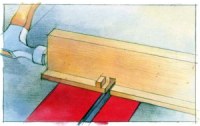 Step 7. Step 7.Chances are your jig will need some adjustment to achieve the necessary finger width. If the fingers are too wide, say .255" in our example, tap the end of the jig closest to the blade with a hammer as shown above. Make more test cuts and tapping adjustments as necessary. If the fingers are too narrow (.245" in our example), tap the other end of the jig. Even though the jig is screwed in place, the hammer taps will make these fine adjustments. |
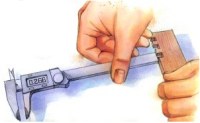 Step 8. Step 8.With your calipers, check the depth of the fingers in your scrap stock. Adjust the height of your blade until the depth reads .016" more than the width of your fingers (.266" in our example). This leaves the fingers long enough so you can sand them flush with the box. |

